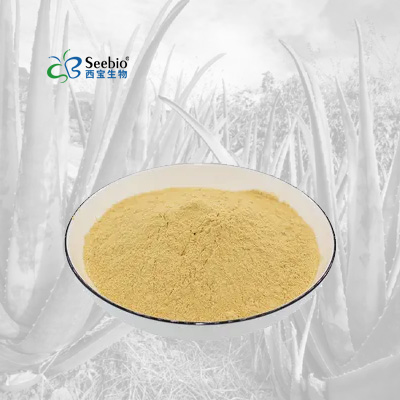Summary
Aloe emodin is a hydroxyanthraquinone that has anti-inflammatory, anti-tumor, anti-viral, and laxative effects. It has been used as a standard in high performance liquid chromatography (HPLC) for separation and identification of phenolic compounds in Aloe arborescens Miller var3.
Properties
CAS Number: 481-72-1
Molecular Formula: C15H10O5
Molecular Weight: 270.24 g/mol
Product Detail
Aloe emodin is one of the main components of aloe essential oil, present in free form in aloe vera or as a ligand in rhubarb, senna leaves, and aloe vera. The precipitate from toluene or ethanol is an orange yellow needle shaped crystal. The relative molecular weight is 270.25. Melting point 223-224 ℃. It can sublimate in a carbon dioxide airflow. It is easily soluble in hot ethanol, ether, and benzene, and the solution is yellow in color. It is also soluble in ammonia solution and sulfuric acid, and the solution is crimson in color.
Aloe vera emodin can inhibit cholesterol absorption, and in addition, it can effectively promote intestinal peristalsis, thus having a certain effect on reducing fat and weight loss.
Aloe emodin is an antibacterial active ingredient of rhubarb, which is a chemical substance with orange needle shaped crystals (toluene) or earthy yellow crystalline powder. Aloe emodin can be extracted from aloe vera, which has many benefits for human health. Aloe emodin has anti-tumor activity, antibacterial activity, immunosuppressive effect, and laxative effect, and is widely used as a raw material for drugs and cosmetics.
Anti tumor effect: In recent years, scholars at home and abroad have been interested in the anti-tumor effect of aloe emodin. Its main anti-tumor activity is concentrated in tumors such as neuroectodermal tumors, liver cancer, lung squamous cell carcinoma, skin Merkel cell carcinoma, gastric cancer, leukemia, etc. The anticancer range is wide, and aloe emodin has an inhibitory effect on P388 leukemia cells, which can prolong survival. One of its mechanisms of action is to inhibit the biosynthesis of DNA, RNA, and proteins in cancer cells.
Antibacterial activity: At a concentration of 1.5-25mg/ml, aloe emodin has inhibitory effects on Staphylococcus, Streptococcus, Diphtheria, Bacillus subtilis, Anthrax, Paratyphoid, and Shigella, among which Staphylococcus and Streptococcus are the most sensitive, with an effective concentration of 15-25ug/ml. The in vitro inhibitory concentrations of Staphylococcus aureus 209P, Escherichia coli and Shigella flexneri were 7.5mg/L and 600mg/L respectively. Their antibacterial effects were bacteriostatic rather than bactericidal. One of its mechanisms of action is to inhibit electron transfer in the mitochondrial respiratory chain. Aloe emodin has a strong inhibitory effect on the synthesis of nucleic acid and protein in Staphylococcus aureus. Aloe emodin has a strong inhibitory effect on common anaerobic bacteria in clinical practice, among which it can inhibit the growth of common fragile bacteria by 90% to 100%, and its MIC is slightly higher than that of metronidazole. At 8 μ The concentration of g/ml can inhibit 76% to 91% of anaerobic bacteria.
Immunosuppressive effect: Aloe emodin can inhibit the production of biological antibodies, inhibit carbon particle clearance ability, reduce the weight of immune organs, reduce white blood cell count, and reduce the function of peritoneal macrophages. Extracorporeal at 100 μ The concentration of g/ml has a significant inhibitory effect on the incorporation of [3H] - TDR and [3H] Urd into lymphocytes.
Purgative effect: Aloe emodin has strong purgative activity, and intestinal bacteria metabolize Aloe emodin, rhein, and anthrone rhein. The latter has a strong purgative effect on Chemicalbook. Clinically used as a laxative, it has the effect of enhancing appetite and relieving diarrhea in the large intestine. According to foreign medical reports, aloe glycoside is hydrolyzed into aloe emodin under the action of parasitic bacteria in the human body. This aloe emodin stimulates the peristalsis of the intestinal wall. At the same time, due to the change of osmotic pressure, it is conducive to the elimination of waste in the intestinal tract, so as to achieve irritating diarrhea. This stimulating diarrhea has special effects on constipation and hemorrhoids. Especially for middle-aged and elderly constipation, the treatment effect is more obvious.
